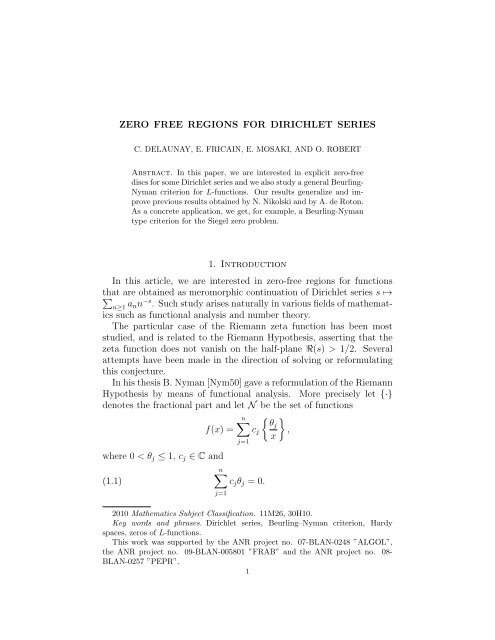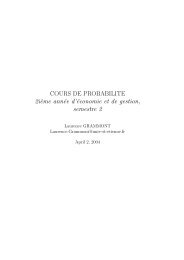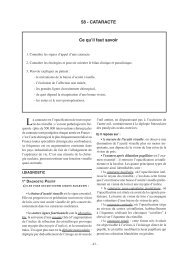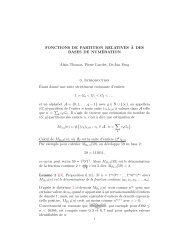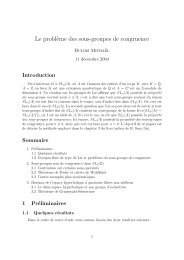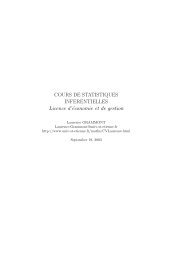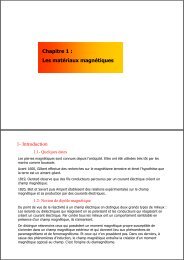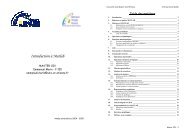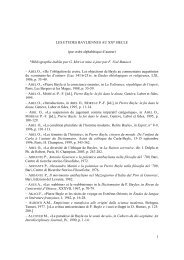ZERO FREE REGIONS FOR DIRICHLET SERIES 1. Introduction In ...
ZERO FREE REGIONS FOR DIRICHLET SERIES 1. Introduction In ...
ZERO FREE REGIONS FOR DIRICHLET SERIES 1. Introduction In ...
- No tags were found...
You also want an ePaper? Increase the reach of your titles
YUMPU automatically turns print PDFs into web optimized ePapers that Google loves.
<strong>ZERO</strong> <strong>FREE</strong> <strong>REGIONS</strong> <strong>FOR</strong> <strong>DIRICHLET</strong> <strong>SERIES</strong> 5)dtt that vanish almost ev-1−2σthe subspace of functions in L ( 2 (0, +∞),erywhere on (1, +∞).We defineψ(u) = res (L(s) ˆϕ(s)u s , s = 1) − ∑ ( na n ϕu)n σ 0 . The following gives a criterion for this property.Theorem 2.<strong>1.</strong> Let r > σ 0 . If m L ≥ 1, we assume furthermore thatr ≠ <strong>1.</strong> The following are equivalent:(i) The function ψ belongs to L 2 du((1, +∞), ).u 1+2r(ii) The function t ↦−→ L(r + it) ˆϕ(r + it) belongs to L 2 (R).We will see in Corollary 3.4 that the conditions (i) and (ii) above aresatisfied whenever r > <strong>1.</strong> Furthermore, Theorem 2.1 is a generalizationof [dR07a, Proposition 3.3] when ϕ = χ (0,1) and r = 1/2.We see that the second condition of the theorem above dependson some growth estimates of L in vertical strip which is, in its turn,linked with questions related to the convexity bound and to the Lindelöfhypothesis. <strong>In</strong> particular, if L is a function in the Selberg class, thenone can prove that L satisfies the generalized Lindelöf hypothesis if andonly if for every k ∈ N, we have(2.1) t ↦−→ Lk ( 1 + it) 21+ it ∈ L 2 (R).2Note that with the special choice of ϕ = χ (0,1) , then ˆϕ(s) = 1/s and thecondition (ii) above for r = 1/2 means exactly that (2.1) is satisfiedfor k = <strong>1.</strong> Moreover, in [dR07a] using the functional equation, it isshown that the condition ψ ∈ L 2 ((1, +∞), du ) (in the case ϕ = χu 2 (0,1) )is necessary for the generalized Riemann Hypothesis for L-functions inthe Selberg class to hold. <strong>In</strong> [dR07b], it is also shown that the conditionon ψ (still with ϕ = χ (0,1) ) is satisfied for L-functions in the Selbergclass of degree less than 4.Fix an integer m ≥ 0 and let W = ⋃ n≥1 (0, 1]n . We say that α ∈ Wis of length n if α belongs to (0, 1] n . For each α in W , its length isdenoted by l(α). Now let α ∈ W and c ∈ C l(α) , we say that A = (α, c)is an m-admissible sequence if(2.2)l(α)∑c j α j (log α j ) k = 0 for all 0 ≤ k ≤ m − <strong>1.</strong>j=1
8 C. DELAUNAY, E. FRICAIN, E. MOSAKI, AND O. ROBERTAn other consequence of Theorem 2.2 is, in a way, a Beurling-Nymancriterion for Dirichlet L-functions. More precisely, let χ be a Dirichletcharacter with conductor q and L(χ, s) its L-function. Then, for 1/2 ≤r < 1, we define d r byd r = minl,c,α⎛⎝∫ 10∣ t1−r − t rl∑j=1c j∑n 0 and some 1/2 ≤ r ≤ 1, then L(χ, σ) does notvanish in the real-interval σ > 1 − C/ log q.If we could take C independent of χ in (2.4), then Theorem 2.5 wouldsolve the Siegel zero problem.<strong>In</strong> order to obtain the criterion for the Siegel zero problem, then weconsider all Dirichlet characters χ and an absolute constant C independantof χ.The next section is devoted to the proof of Theorem 2.1 and tothe study of the function ψ. Section 4 will focus on the admissiblesequences and the functions f A,r . Theorem 2.2 and Corollary 2.3 willbe proven in Section 5 and Theorem 2.4 will be proven in Section 6.Some explicit examples will be studied in Section 7 in which we willprove Theorem 2.5.2dtt⎞⎠123. The function ψ and proof of theorem 2.1We define the functions ψ 1 and ψ 2 byψ 1 (u) = res (L(s) ˆϕ(s)u s , s = 1) (u ∈ R + ),ψ 2 (u) = ∑ ( na n ϕ (u ∈ R + ),u)n
write<strong>ZERO</strong> <strong>FREE</strong> <strong>REGIONS</strong> <strong>FOR</strong> <strong>DIRICHLET</strong> <strong>SERIES</strong> 9(3.1) L(s) ˆϕ(s) =with H analytic in Π σ0 .Lemma 3.<strong>1.</strong> We have(3.2) H(s) =∫ 1where φ(t) = ψ(1/t)χ (0,1) (t).0∑m Lk=1p −k(s − 1) k − H(s),( ) 1ψ t s−1 dt =t ˆφ(s), R(s) > 1,Proof of Lemma 3.<strong>1.</strong> On the one hand, we have(3.3) L(s) ˆϕ(s) =∫ +∞On the other hand, the equality(3.4)∫ +∞11ψ 2 (u)u −s−1 du, R(s) > <strong>1.</strong>ψ 1 (u)u −s−1 du =∑m Lk=1p −k(s − 1) kfollows by linearity using the classical identities( )us(3.5) res(s − 1) , s = 1 u(log u)k−1= k (k − 1)!and1(k − 1)!∫ +∞1(log u) k−1 u −s du =1(s − 1) k .Equations (3.3) and (3.4) imply now the expected result.□Remark 3.2. From (3.1) and (3.5), we easily see that we can writeψ 1 (t) = tP (log t) where P is a polynomial of degree < m L (P ≡ 0 ifm L = 0). More precisely we have∑m Lp −kψ 1 (t) = t(k − 1)! (log t)k−1 .k=1Lemma 3.3. The function s ↦→ H(s) is of finite order on Π r . Moreover,for all σ > 1, the function t ↦→ H(σ + it) belongs to L 2 (R) and∫( ) 1|H(σ + it)| 2 dt = Ofor σ → +∞.Rσ 1−2σ 1
10 C. DELAUNAY, E. FRICAIN, E. MOSAKI, AND O. ROBERTProof of Lemma 3.3. The function s ↦→ H(s) is bounded on a neighborhoodV 1 of s = <strong>1.</strong> The functions s ↦→ ∑ p −jjand (by assumption)s ↦→ L(s) are of finite order on Π σ0 V 1 . Moreover, since(s−1) jϕ(x) = O(x −σ 0(1 − x) −σ 1) and r > σ 0 , it is clear that s ↦→ ˆϕ(s) isbounded on the closure of Π r . Hence we can conclude that H is offinite order on Π r , which proves the first part of the lemma.Let σ > 1 be a fixed real number. We easily check that, for every j ≥ 1,the function t ↦−→ (σ − 1 + it) −j belongs to L 2 (R) and we have∫∣ 1 ∣∣∣2 ( ) 1(3.6) ∣dt = O , σ → +∞.(σ + it − 1) j σ 2j−1RNow, Plancherel’s formula and the estimate ϕ(x) = O(x −σ 0(1 − x) −σ 1)yield∫∫ 1| ˆϕ(σ + it)| 2 dt = 2π |ϕ(x)| 2 x 2σ dxR0x(∫ 1)= O x 2σ−2σ0−1 (1 − x) −2σ 1dx .Then, the classical identityβ(A, 1 − 2σ 1 ) :=0∫ 1and Stirling’s formula give∫ 1(x A−1 (1 − x) 1−2σ 1 1dx = O00x A−1 (1 − x) 1−2σ 1dx = Γ(A)Γ(1 − 2σ 1)Γ(A + 1 − 2σ 1 )A 1−2σ 1), A → +∞,and we can conclude (recall that s ↦→ L(s) is bounded in Π σ ).Now we can prove Theorem 2.<strong>1.</strong>Assume that (i) is satisfied. Then the function φ(t) = ψ ( )1 χ(0,1) (t)tbelongs to L 2 dt∗((0, 1), ) and thus the function G := ˆφ belongs tot 1−2rH 2 (Π r ). The analytic continuation principle implies that the equality(3.2) is satisfied for every s ∈ Π r , that is H(s) = ˆφ(s) = G(s), s ∈ Π r .Since G ∈ H 2 (Π r ), we know that the function G ∗ , defined byG ∗ (t) := lim G(σ + it),σ→> rexists almost everywhere on R and belongs to L 2 (R). ButG ∗ (t) = lim H(σ + it) = H(r + it),σ→> rbecause H is continuous on the closed half-plane R(s) ≥ r. Thereforet ↦−→ H(r + it) belongs to L 2 (R). It remains to notice that for every□
<strong>ZERO</strong> <strong>FREE</strong> <strong>REGIONS</strong> <strong>FOR</strong> <strong>DIRICHLET</strong> <strong>SERIES</strong> 111 ≤ k ≤ m L , the function t ↦−→ (r − 1 + it) −k belongs to L 2 (R) (this iswhere we have to assume that r ≠ 1 whenever m L ≥ 1). Thus accordingto (3.1), we get that t ↦→ L(r + it) ˆϕ(r + it) belongs to L 2 (R).Conversely assume that (ii) is satisfied. Then the function t ↦−→H(r + it) belongs to L 2 (R).Let σ 2 > max(1, r). The function H is analytic on Ω := {s : r max(1, r), we have ˆφ 1 (s) = H(s) = ˆφ(s).By injectivity of the Mellin transform, we get that( ) 1ψ χ (0,1) (t) = φ(t) = φ 1 (t).tThus t ↦−→ ψ ( ) ( )1 χ(0,1) (t) belongs to L 2 t ∗ (0, 1),dtt , which implies1−2rthat ψ belongs to L ( ) 2 du(1, +∞),u and that concludes the proof of1+2rTheorem 2.<strong>1.</strong>□Corollary 3.4. Let r > <strong>1.</strong> Then ψ ∈ L 2 ( (1, +∞),‖ψ‖ 2 = O ( r σ 1−1/2 ) , as r → +∞.)duu and we have1+2rProof. Let r > 1 be a fixed real number. By Lemma 3.3, the functiont ↦−→ H(r+it) belongs to L 2 (R) and for every 1 ≤ j ≤ m L , the functiont ↦−→ (r − 1 + it) −j belongs also to L 2 (R). Therefore it follows from(3.1) that t ↦−→ L(r + it) ˆϕ(r + it) belongs to L 2 (R) and Theorem 2.1implies that ψ ∈ L 2 du((1, +∞), ). Moreover, if we let as beforeu 1+2rφ(t) = ψ(1/t)χ (0,1) (t), we have by Plancherel’s formula‖ψ‖ 2 2 =∫ +∞1|ψ(u)| 2 du ∫ 1( )∣u = 1 ∣∣∣21+2r ∣ ψ t= ‖φ‖ 2 L 2 ∗ ((0,1), dtt 1−2r )= 1 ∫|2πˆφ(r + it)| 2 dtR= 1 ∫|H(r + it)| 2 dt,2πR0dtt 1−2r
12 C. DELAUNAY, E. FRICAIN, E. MOSAKI, AND O. ROBERTand Lemma 3.3 gives the result.□Remark 3.5. <strong>In</strong> fact, if the coefficients of L(s) have some nice arithmeticalproperties, for example so that a Wiener-Ikehara type theoremcan be applied to L(s), one can expect that the main contributions ofψ 1 will be compensated by the main contributions of ψ 2 and so that thefunction ψ will belong to the space L ( ) 2 du(1, +∞),u for smaller value1+2rof r. For example, if L(s) = ζ(s) and if ϕ(t) = χ 0,1 (t) for all t ∈ (0, 1),then ψ(u) = u − ⌈u⌉ + 1 (so ψ(u) = {u} for almost all u ∈ (1, ∞))and ψ ∈ L ( ) 2 du(1, +∞),u for all r > 0. <strong>In</strong> this case ˆϕ(s) = 1/s and1+2rt ↦→ |ζ(r + it)|/|r + it| ∈ L 2 (R) for all r > 0 as expected by Theorem2.<strong>1.</strong> We will discuss other examples in Section 7.Remark 3.6. Assume that ϕ is bounded at t = 1 (which correspondsto σ 1 = 0). Thus, for every α > 1, we have ψ(t) = ψ 1 (t) − ψ 2 (t) =O(t α ), t → +∞. <strong>In</strong>deed, on the one hand, ψ 1 (t) = tP (log t), where Pis a polynomial of degree < m L . On the other hand, let α > 1 be afixed real number. Then there exists a constant C > 0 such thatHence we get|ψ 2 (t)| ≤ ∑ n
<strong>ZERO</strong> <strong>FREE</strong> <strong>REGIONS</strong> <strong>FOR</strong> <strong>DIRICHLET</strong> <strong>SERIES</strong> 13(1) For any polynomial P of degree d < m, for any real t > 0, wehavel(α)∑c j α j P (log(α j /t)) = 0.j=1(2) For any positive real number λ 1 and for any real number λ 2 ≥max j (α j ), the sequences ((α λ 1j ) j, (c j α 1−λ 1j ) j ) and ((α j /λ 2 ) j , c)are both m-admissible sequences.Proof. (1) If t = 1, the equality comes from the definition. If t > 0,we apply the result for t = 1 to the polynomial P t (X) = P (X − log t).The rest of the proof follows immediately from the definition. □For an m-admissible sequence A = (α, c) we define the entire functionl(α)∑g A (s) = c j αjsj=1(s ∈ C).Using (2.2), we notice that these functions satisfy(4.1) g (k)A(1) = 0 (0 ≤ k ≤ m − 1).Lemma 4.2. Let m be a nonnegative integer. Then we have the following(1) For every integer l ≥ m+1 and every 0 < α 1 < α 2 < · · · < α l ≤1, there exists c ∈ C l such that A = (α, c) is an m-admissiblesequence and g (m)A (1) ≠ 0. Furthermore we can choose c l ≠ 0.(2) For every s 1 ∈ C {1}, there exists an m-admissible sequenceA such that g A (s 1 ) ≠ 0.Proof. (1) Let l ≥ m+1, then there is a unique vector (b 1 , b 2 , . . . , b m , b l ) ∈C m+1 such that(4.2)⎛⎜⎝⎞ ⎛1 . . . . . . 1 1(log α 1 ) . . . . . . (log α m ) (log α l )⎟ ⎜.. .⎠ ⎝(log α 1 ) m . . . . . . (log α m ) m (log α l ) mb <strong>1.</strong>b mb l⎞ ⎛⎟⎠ = ⎜⎝since the corresponding van der Monde matrix is invertible. Setting⎧b j⎪⎨ α j, 1 ≤ j ≤ mc j = 0, m + 1 ≤ j ≤ l − 1⎪⎩ b lα l, j = l.0.01⎞⎟⎠ ,
14 C. DELAUNAY, E. FRICAIN, E. MOSAKI, AND O. ROBERTThen A = (α, c) is an m-admissible sequence and g (m)A(1) = <strong>1.</strong> Furthermorewe see that b l ≠ 0 (otherwise, we would have easily b 1 = b 2 =· · · = b m = b l = 0, which contradicts (4.2)), therefore c l ≠ 0.(2) Let A = (α, c) be a non trivial m-admissible sequence.For 0 < λ < 1, consider g Aλ (s) = g A (1 − λ + λs). Note thatl∑g Aλ (s) = c j α 1−λj (αj λ ) s ,j=1and, by Lemma 4.1, A λ = ((αj λ ) j , (c j α 1−λj ) j ) is an m-admissible sequence.Now let s 1 ≠ 1; then there necessarily exists 0 < λ < 1 suchthat g Aλ (s 1 ) ≠ 0, since g A is analytic and non identically zero. □Theorem 4.3. Let r > σ 0 such that ψ ∈ L 2 du((1, +∞), ) and letu 1+2rA = (α, c) be an m L -admissible sequence. We definel(α)∑f A,r (t) = t r−σ 0c j ψj=1Then we have:(1) f A,r (t) = 0, if t > max j α j .(2) f A,r (t) ∈ L 2 dt∗((0, 1), ). t 1−2σ 0(3) For R(s) > σ 0 , we have(4.3)( αjt)(t > 0).̂f A,r (s) = −L(s + r − σ 0 ) ˆϕ(s + r − σ 0 )g A (s + r − σ 0 ).Proof. (1) We write ψ = ψ 1 − ψ 2 with ψ 1 (u) = res (L(s) ˆϕ(s)u s , s = 1)and ψ 2 (u) = ∑ n
<strong>ZERO</strong> <strong>FREE</strong> <strong>REGIONS</strong> <strong>FOR</strong> <strong>DIRICHLET</strong> <strong>SERIES</strong> 15and∫ +∞α j‖α‖|ψ(u)| 2 du ∫ 1u = |ψ 1+2r α 1 (u)| 2 du ∫ +∞j u + |ψ(u)| 2 du1+2r 1 u , 1+2r ‖α‖since ψ(u) = ψ 1 (u) for u < <strong>1.</strong> Now, by hypothesis, the second integralis finite and the first integral is also finite because ψ 1 (u) = uP (log u)and α j> 0. Since f ‖α‖ A,r(t) = 0 for t > ‖α‖, the expected result followsby linearity. Furthermore, we see that(4.4) ‖f A,r ‖ L 2 ∗ ((0,1),⎛⎛l(α)∑|c j αj|r ⎜⎝⎝j=1dtt 1−2σ ) ≤0∫ 1⎞|ψmin j α 1 (u)| 2 du⎠j u 1+2r max j α j1/2+ ‖ψ‖ L 2 ((1,+∞),⎞⎟duu 1+2r )⎠ .(3) For R(s) > 1, we have by (3.3)L(s) ˆϕ(s) =Hence∫ +∞1ψ 2 (u)u −s−1 du.l(α)∑L(s) ˆϕ(s) c j αj s =j=1==l(α)∑∫ +∞( ) −s uc j ψ 2 (u) du α j uj=11l(α)∑∫ αjc jj=10l(α)∑∫ 1c jj=10( αj) dtψ 2t t 1−s( αj) dtψ 2t t , 1−sthe last equality follows from ψ 2 (α j /t) = 0 if α j < t ≤ <strong>1.</strong>Using once more Lemma 4.1 (1), we havel(α)∑c j ψj=1( αjt) l(α)∑ ( αj)= − c j ψ 2 , (t > 0),tj=1
16 C. DELAUNAY, E. FRICAIN, E. MOSAKI, AND O. ROBERTwhencel(α)∑L(s) ˆϕ(s) c j αj s = −j=1= −= −∫ 10∫ 10∫ 10⎛l(α)∑⎝ c j ψj=1( αjtt σ 0−r f A,r (t) dtt 1−s) ⎞ ⎠ dtf A,r (t)t s+σ 0−r−1 dtt 1−s= − ̂f A,r (s + σ 0 − r), R(s) > <strong>1.</strong>So, for R(s) > 1 + σ 0 − r, we have ̂f A,r (s) = −L(s + r − σ 0 ) ˆϕ(s + r −σ 0 )g A (s + r − σ 0 ). By the analytic continuation principle, the equalityholds for R(s) > σ 0 . (Note that from (4.1) the pole of L(s + r − σ 0 ) iskilled by the zero of g A (s + r − σ 0 ) at s = 1 − r + σ 0 .)□Remark 4.4. Let m ≥ 1, and let A = (α, c) be an m-admissiblesequence. Then, we havel∑ ( αj) l∑ ( αj) ( )) 1c j ψ = c j(ψ − α j ψ .tt tj=1Thus, if m = 1 and(l∑K r = span t r−σ 0c j ψj=1we easily check thatK r = span(t r−σ 0( αjtj=1)): A = (α, c) a 1-admissible sequence ,( ( α) ( )))1ψ − αψ : 0 < α ≤ 1 .t t<strong>In</strong> particular, if L(s) = ζ(s), ϕ(t) = χ (0,1) (t) (that is σ 1 = 0), we obtainthat ψ(u) = {u} for almost all u ∈ (1, +∞) and then K r = ˜K r , thesubspace introduced in [Nik95].5. Zeros free regions for Dirichlet seriesBefore proving Theorem 2.2 we need some well known tools concerningthe Hardy space H 2 (Π σ0 ). For these we refer to [Hof62, Chapter8]. Actually, in [Hof62], the following facts are stated for the spaceH 2 (Π 0 ) but it is easy to obtain the corresponding results for H 2 (Π σ0 ),for instance using the unitary map h(z) ↦−→ h(z − σ 0 ) from H 2 (Π σ0 )onto H 2 (Π 0 ).
<strong>ZERO</strong> <strong>FREE</strong> <strong>REGIONS</strong> <strong>FOR</strong> <strong>DIRICHLET</strong> <strong>SERIES</strong> 17Recall that if h ∈ H 2 (Π σ0 ), thenh ∗ (σ 0 + it) := limσ→σ0>h(σ + it)exists for almost every t ∈ R (with respect to the Lebesgue measure).Moreover we have h ∗ ∈ L 2 (σ 0 +iR) and ‖h‖ 2 = ‖h ∗ ‖ 2 . We can thereforeidentify (unitarily) H 2 (Π σ0 ) with a (closed) subspace of L 2 (σ 0 +iR). <strong>In</strong>the following we use the symbol h not only for the function in H 2 (Π σ0 )but also for its ”radial ” limit (in other words we forget the star). Thisidentification enables us to consider H 2 (Π σ0 ) as an Hilbert space, withscalar product given by(5.1) 〈h, g〉 2 =∫ +∞−∞h(σ 0 + it)g(σ 0 + it) dt, h, g ∈ H 2 (Π σ0 ).Now for λ ∈ Π σ0 , we have the following integral representationh(λ) = 12π∫ +∞so that we can write, using (5.1),−∞h(σ 0 + it)λ − σ 0 − it dt,(5.2)h(λ) = 〈h, k λ 〉 2 ,where k λ is the function in H 2 (Π σ0 ) defined by(5.3)k λ (z) := 1 12π z − 2σ 0 + ¯λ , z ∈ Π σ 0.The function k λ is called the reproducing kernel of H 2 (Π σ0 ) and wehave(5.4)‖k λ ‖ 2 2 = 〈k λ , k λ 〉 2 = k λ (λ) =14π(R(λ) − σ 0 ) .<strong>In</strong> particular, the linear functional h ↦−→ h(λ) is continuous on H 2 (Π σ0 ).Recall now a useful property of factorization for functions in the Hardyspace.Lemma 5.<strong>1.</strong> Let h ∈ H 2 (Π σ0 ) and µ ∈ Π σ0 such that h(µ) = 0. Thenthere exists g ∈ H 2 (Π σ0 ) such that ‖h‖ 2 = ‖g‖ 2 andh(z) =z − µz + ¯µ − 2σ 0g(z), z ∈ Π σ0 .Proof. See the results in [Hof62, Chapter 8, pp. 132] and apply thetransform h(z) ↦−→ h(z − σ 0 ).□
18 C. DELAUNAY, E. FRICAIN, E. MOSAKI, AND O. ROBERTProof of Theorem 2.2 Denote by E r = MK r , where K r is defined by(2.3). Since the Mellin transform is a unitary map from L 2 dt∗((0, 1), ) t 1−2σ 0onto H 2 (Π σ0 ), we haveE r = span H 2 (Π σ0 ) (h A,r : A a m L -admissible sequence) ,where h A,r (s) = Mf A,r (s), for R(s) > σ 0 . It follows from Theorem 4.3thath A,r (s) = − 1 √2πL(s + r − σ 0 ) ˆϕ(s + r − σ 0 )g A (s + r − σ 0 ), R(s) > σ 0 .Now assume that there is µ ∈ Π σ0 such that L(µ + r − σ 0 ) = 0. Sinceµ ∈ Π σ0 , we get that h A,r (µ) = 0, for every m L -admissible sequence A.Thus, by continuity of h ↦−→ h(µ) in H 2 (Π σ0 ), we also have h(µ) = 0,for all h ∈ E r . Since h ∈ H 2 (Π σ0 ), we know from Lemma 5.1 that thereis g ∈ H 2 (Π σ0 ) such that ‖g‖ 2 = ‖h‖ 2 andz − µh(z) =g(z) (z ∈ Π σ0 ).z + ¯µ − 2σ 0Hence with Cauchy-Schwarz inequality and (5.2), we deduce that∣ ∣ |h(λ)| =λ − µ ∣∣∣ ∣|g(λ)| ≤λ − µ ∣∣∣λ + ¯µ − 2σ 0∣‖g‖ 2 ‖k λ ‖ 2 ,λ + ¯µ − 2σ 0so∣ sup |h(λ)| ≤µ − λ ∣∣∣∣h∈E r µ + ¯λ ‖k λ ‖ 2 .− 2σ 0‖h‖ 2 =1By contraposition, we have proved that L does not vanish on⎧⎫⎨ ∣ ∣ ∣∣∣r − σ 0 +⎩ µ ∈ C : µ − λ ∣∣∣sup h∈Er |h(λ)| ⎬‖h‖µ + ¯λ
<strong>ZERO</strong> <strong>FREE</strong> <strong>REGIONS</strong> <strong>FOR</strong> <strong>DIRICHLET</strong> <strong>SERIES</strong> 19Hencesup h∈Er |h(λ)| 2‖h‖ 2 =1‖k λ ‖ 2 2But for R(s) > σ 0 , we have()M t¯λ−2σ 0χ (0,1) (t) (s) === 1 − dist2 (k λ , E r ).‖k λ ‖ 2 2∫1 1√ t¯λ−2σ 0t s−1 dt2π01 1√2π ¯λ − 2σ 0 + s = √ 2πk λ (s),according to (5.3). Since the Mellin transform is an isometry fromL 2 dt∗((0, 1), ) onto t 1−2σ 0 H2 (Π σ0 ), we obtaindist(k λ , E r ) = 1 √2πdist(t¯λ−2σ 0χ (0,1) (t), K r ) = d r(λ)√2π.We conclude the proof of Theorem 2.2 using ‖k λ ‖ 2 12 = .4π(R(λ)−σ 0 )□Proof of Corollary 2.3 It follows from the proof of Theorem 2.2 and(5.4) that L does not vanish on⎧⎪⎨ ∣ ∣∣∣r − σ 0 +⎪⎩ µ ∈ C : µ − λµ + ¯λ − 2σ 0∣ ∣∣∣< √ 4π(R(λ) − σ 0 ) suph∈E r‖h‖ 2 =1⎫⎪⎬|h(λ)|⎪⎭ .So in particular (with h = h A,r ), we get that L does not vanish on{∣ r − σ 0 + µ ∈ C :µ − λ ∣∣∣∣µ + ¯λ < √ 4π(R(λ) − σ 0 ) |h }A,r(λ)|,− 2σ 0 ‖h A,r ‖ 2which proves corollary 2.3 because h A,r = Mf A,r = 1 √2π̂fA,r .The following could be interesting in applications.Corollary 5.2. Let M be a subspace of K r and λ ∈ Π σ0 . Then L doesnot vanish on the disc{∣ }r−σ 0 + µ ∈ C :µ − λ ∣∣∣2∣µ + ¯λ < 1 − 2(R(λ) − σ 0 )dist 2 (t¯λ−2σ 0χ (0,1) , M) .− 2σ 0Proof. It is sufficient to note thatdist(t¯λ−2σ 0χ (0,1) , M) ≥ dist(t¯λ−2σ 0χ (0,1) , K r ) = d r (λ)and then apply Theorem 2.2.Adapting the proof of Theorem 2.2, we could obtain immediatelythe following generalization.□□
20 C. DELAUNAY, E. FRICAIN, E. MOSAKI, AND O. ROBERTTheorem 5.3. Let k ∈ N and λ ∈ Π σ0 . The function L does not haveany zero of order greater or equal to k on{∣ r − σ 0 + µ ∈ C :µ − λ ∣∣∣∣µ + ¯λ < ( 1 − 2(R(λ) − σ 0 )d 2− 2σr(λ) ) }12k.06. A Beurling–Nyman type theorem for Dirichlet seriesOne of the main steps for proving Theorem 2.4 is to prove thatthe space E r is a closed subspace of H 2 (Π σ0 ) that is invariant undermultiplication operator τ v , v ≥ 0, and then to apply Lax–Beurling’stheorem. Before recalling this theorem, we give some notations andresults. We refer to [Nik02, Part A, Chap. 2 & 6] for more details.For v ∈ R, let τ v be the operator of multiplication on L 2 (σ 0 + iR)defined by(τ v f)(σ 0 + it) = e −ivt f(σ 0 + it) (f ∈ L 2 (σ 0 + iR)).We also denote by H ∞ (Π σ0 ) the Hardy space of bounded analyticfunctions on Π σ0 ; as in H 2 (Π σ0 ), functions in H ∞ (Π σ0 ) admit ”radial”limits at almost every points of the boundary R(s) = σ 0 and iff ∈ H ∞ (Π σ0 ) and f ∗ is its boundary limits, then f ∗ ∈ L ∞ (σ 0 + iR)and ‖f ∗ ‖ ∞ = ‖f‖ ∞ (= sup z∈Πσ0 |f(z)|). A function Θ in H ∞ (Π σ0 ) issaid to be inner if |Θ(σ 0 + it)| = 1 for almost every point t ∈ R.It is easy to see that if Θ is inner and E = ΘH 2 (Π σ0 ), then E isa closed subspace of H 2 (Π σ0 ) invariant by τ v , v ≥ 0. Lax–Beurling’stheorem gives the converse.Theorem 6.1 (Lax–Beurling). Let E be a closed subspace of H 2 (Π σ0 )such that τ v E ⊂ E, ∀v ≥ 0. Then there is an inner function Θ ∈H ∞ (Π σ0 ) unique (up to a constant of modulus one) such that E =ΘH 2 (Π σ0 ).Remark 6.2. When E is spanned by a family of functions, we canprecise a little bit more the conclusion of Theorem 6.<strong>1.</strong> <strong>In</strong>deed, letE be a closed subspace of H 2 (Π σ0 ) spanned by a family of functions(f i ) i∈I , f i ∈ H 2 (Π σ0 ) and let f i = h i g i be the factorization of f i in innerfactor h i and outer factor g i . If τ v E ⊂ E, ∀v ≥ 0, then E = ΘH 2 (Π σ0 ),where Θ = gcd(h i : i ∈ I) is the greatest common inner divisor of thefamily (h i ) i∈I .Proof of Theorem 2.4 First of all, note that⋂(6.1) h −1 ({0}) = {s ∈ Π σ0 : L(s + r − σ 0 ) = 0},h∈E r
22 C. DELAUNAY, E. FRICAIN, E. MOSAKI, AND O. ROBERTthe functions f A,r span the subspace K r , we deduce (6.2). Thereforewe obtain that E r = MK r is a closed subspace of H 2 (Π σ0 ) which isinvariant under the semi-group of operators MS β M −1 , 0 < β ≤ <strong>1.</strong>Now let us show that(6.3)MS β M −1 = τ v ,with v = − log β. If h ∈ H 2 (Π σ0 ) and if f ∈ L 2 dt∗((0, 1), ) is sucht 1−2σ 0that M −1 h = f, we have for R(s) > σ 0 ,Hence we have(MS β M −1 h)(s) = √ 1 ∫ ∞(S β f)(t)t s−1 dt2π 0= √ 1 ∫ +∞( )β −σ 0 tf t s−1 dt2π β0∫=β s−σ 1 +∞0√ f(u)u s−1 du2π0=β s−σ 0(Mf)(s) = β s−σ 0h(s).(MS β M −1 h)(σ 0 +it) = β it h(σ 0 +it) = e it log β h(σ 0 +it) = (τ v h)(σ 0 +it),with v = − log β, which proves (6.3). We therefore obtain that τ v E r ⊂E r , for all v ≥ 0 and then Lax–Beurling’s Theorem (see Theorem 6.1)implies that there is an inner function Θ in the half-plane Π σ0 suchthat E r = ΘH 2 (Π σ0 ). Moreover we know that Θ = BS, where Bis a Blaschke product and S is a singular inner function ([Nik02]).But according to Remark 6.2, the zeros of B coincide with the set ofcommon zeros of functions h ∈ E r . Hence it follows from (6.1) andthe hypothesis that B has no zeros. <strong>In</strong> other words, B ≡ <strong>1.</strong> Wewill now show that S ≡ <strong>1.</strong> First note that since h A,r is analytic onR(s) > 2σ 0 − r and since S is a common inner divisor of all functionsin E r , it follows that S can be continued analytically through the axisσ 0 + iR. <strong>In</strong> particular, this forces S to be of the form S(s) = e −a(s−σ0) ,for some a ≥ 0 (see for instance [Nik02, Part A, Chap. 4 & 6]). Nowlet h A,r be a function in E r and write h A,r = Sh, with h ∈ H 2 (Π σ0 ).Lemma 6.3. Let h ∈ H 2 (Π σ0 ). Thenlim supσ→+∞log |h(σ)|σ≤ 0.Proof of lemma 6.3. Using (5.2) and (5.4), we get|h(σ)| ≤ ‖h‖ 2 ‖k σ ‖ 2 =‖h‖ 22 √ π(σ − σ 0 ) 1/2 ,
<strong>ZERO</strong> <strong>FREE</strong> <strong>REGIONS</strong> <strong>FOR</strong> <strong>DIRICHLET</strong> <strong>SERIES</strong> 23for every σ > σ 0 . Hencelog |h(σ)|≤ O(1)σ σ − 1 2which gives the result letting σ → +∞.log(σ − σ 0 ),σ□On the one hand, according to the previous lemma, we have(6.4)lim supx→+∞log |h A,r (x)|xAnd on the other hand, writing≤ lim supx→+∞log |S(x)|x= −a ≤ 0.l(α)∑h A,r (x) = L(x + r − σ 0 ) ˆϕ(x + r − σ 0 ) c j α x+r−σ 0j ,we can assume, by Lemma 4.2, that 0 < α 1 < · · · < α l(α) = 1 and thatc l(α) ≠ 0. Then we havej=1|h A,r (x)| ∼ |a 1 || ˆϕ(x + r − σ 0 )c l(α) |, x → +∞.Hence we can find x 0 > 1 such that|h A,r (x)| ≥ |a 1|2 | ˆϕ(x + r − σ 0)c l(α) |, (x > x 0 ),which giveslog |h A,r (x)| ≥ − log 2+log |a 1 |+log |c l(α) |+log | ˆϕ(x+r−σ 0 )|, (x > x 0 ).Therefore we obtain thatlim supx→+∞log |h A,r (x)|x≥ lim supx→+∞log | ˆϕ(x + r − σ 0 )|x= 0.Using (6.4), we conclude that a = 0. Hence S ≡ 1, which givesE r = H 2 (Π σ0 ), that is K r = L 2 dt∗((0, 1), ).□t 1−2σ 0Remark 6.4. <strong>In</strong> fact, with the hypothesis on ϕ, one can easily showlog | ˆϕ(x+r−σthat we always have lim sup 0 )|x→+∞ ≤ 0. Note that therexexists some ϕ for which the lim sup is negative.7. Some examples and applications7.<strong>1.</strong> The Riemann zeta function. Letζ(s) = ∑ 1(R(s) > 1),n s n≥1be the Riemann zeta function. Then it is well known that ζ can bemeromorphically continued in the whole plane C, with a unique poleof order 1 at the point s = 1 ([Tit86]). Thus, the function ζ satisfies
24 C. DELAUNAY, E. FRICAIN, E. MOSAKI, AND O. ROBERTour hypothesis with m L = 1 (and for instance, σ 0 = 0). Now let usconsider the function ϕ defined on [0, +∞[ by{(1 − t) −σ 1if 0 ≤ t < 1ϕ(t) =,0 if t ≥ 1where σ 1 < 1/2 is fixed.Then an elementary computation shows that ˆϕ(s) = Γ(s)Γ(1−σ 1),Γ(s+1−σ 1 )R(s) > 0. Hence,(7.1) | ˆϕ(s)| ∼ Γ(1 − σ 1)|t| 1−σ 1as |t| = |I(s)| → ∞.We now illustrate 1 the use of Theorem 2.1 in order to determine thevalues of r such that)ψ ∈ L((1, 2 du∞), .u 1+2rAn obvious computation shows thatψ(u) =u − ∑ 1( )1 − σ 1n 0.uLet µ = µ(1/2) be a convexity bound for ζ(1/2 + it) ([Ten08]), so thatwe have for all ε > 0,){O ε(|t| 1 2 −(1−2µ)r+ε if 0 ≤ r ≤ 1/2,|ζ(r + it)| = (O ) ε |t|2µ(1−r)+εif 1/2 ≤ r < <strong>1.</strong>We get from (7.1)|ζ(r + it) ˆϕ(r + it)| 2 =So a direct application of Theorem 2.1 gives:{O ε(|t|−1−(2−4µ)r+2σ 1 +ε ) if 0 ≤ r ≤ 1/2,O ε(|t|−2+2σ 1 +4µ(1−r)+ε ) if 1/2 ≤ r < <strong>1.</strong>Proposition 7.<strong>1.</strong> With the notation above, then ψ ∈ L ( 2 (1, ∞),if one the following holds:• max(0, σ 1 /(1 − 2µ)) < r ≤ 1/2;• max(1/2, 1 − (1 − 2σ 1 )/(4µ)) < r < 1;• r > <strong>1.</strong>)duu 1+2r1 It is an illustration since here Theorem 2.1 is useless as it can be seen in Theorem7.2.
<strong>ZERO</strong> <strong>FREE</strong> <strong>REGIONS</strong> <strong>FOR</strong> <strong>DIRICHLET</strong> <strong>SERIES</strong> 25By a result of Huxley ([Hux05]), we can take µ = 32 . <strong>In</strong> particular,205one may have r = 1/2 if σ 1 is chosen such that σ 1 < 141 ≈ 0.343 . . . .410If we assume the Lindelöf Hypothesis, we have µ = 0 and a similarcomputation as above implies that if r ≠ 1 and r > max(0, σ 1 ), then)ψ ∈ L((1, 2 du∞), .u 1+2r<strong>In</strong> fact, the work above is useless for the Riemann zeta function sincewe can prove directly the following:Theorem 7.2. Let r ≠ <strong>1.</strong> Then ψ ∈ L 2 du((1, ∞), ) if and only ifu 1+2rr > max(0, σ 1 ). Moreover, if the condition holds we havewhere‖ψ‖ 2 ≤ 1 L 2 du((1,∞),u 1+2r ) 2r + C(σ 1)ζ(1 + 2r − 2σ 1 )C(σ 1 ) =11+1 − 2σ 1 (1 − σ 1 ) 2 (3 − 2σ 1 ) + ε 1(1 − σ 1 ) 2and ε 1 = 1 if σ 1 ≥ 0 and ε 1 = −1 if σ 1 < 0.Proof. <strong>In</strong> the case of the zeta function and for the previous choice ofϕ, we haveψ(u) =u − ∑ (1 − n −σ1(u > 0).1 − σ 1 u)n
26 C. DELAUNAY, E. FRICAIN, E. MOSAKI, AND O. ROBERTWith the definition of ε 1 , the function t ↦→ ε 1 (u − t) −σ 1is increasingfor t ∈ [0, u). Then∫ lε 1 u −σ 1+ε 1 (u−t) −σ 1dt ≤ ε 1whence0l∑∫ l(u − n) −σ 1≤ ε 1 (u−l) −σ 1+ε 1 (u−t) −σ 1dt,n=0ε 1 u −σ 1− ε 1 (u − l) −σ 1+ ε 1(u − l) 1−σ 11 − σ 1≤ ε 1 ∆ l (u) ≤ ε 1(u − l) 1−σ 11 − σ 1,which immediately gives (7.2). Applying (7.2) gives∞∑∫ 1()‖ψ‖ 2 2 ≤ |(u + k) −σ 1− u −σ 1| + u1−σ 1 2du1 − σ 1 (u + k) .1+2r−2σ 1k=10Using the fact that |(u + k) −σ 1− u −σ 1| = ε 1 (u −σ 1− (u + k) −σ 1) andexpanding each integral, we get(7.3) ‖ψ‖ 2 2 ≤where we setandIt is now clear that∫ 10θ A (u) = ∑ k≥1(θ2σ1 (u)ξ σ1 (u) 2 − 2θ σ1 (u)ξ σ1 (u) + θ 0 (u) ) du,ξ σ1 (u) = u −σ 1+ ε 1u 1−σ 11 − σ 11, (A < 2r).(u + k)1+2r−A(7.4) θ σ1 (u)ξ σ1 (u) ≥ 0 (0 ≤ u ≤ 1, σ 1 < 1/2),(note that by assumption σ 1 < 1/2). Hence‖ψ‖ 2 2 ≤∫ 10(θ2σ1 (u)ξ σ1 (u) 2 + θ 0 (u) ) du.A simple computation yields ∫ 1θ 0 0(u) du = 1 . For the remaining term,2rnoting that for any A < 2r, we have θ A (u) ≤ ζ(1 + 2r − A), we obtain‖ψ‖ 2 2 ≤ 1 2r + ζ(1 + 2r − 2σ 1)∫ 10ξ σ1 (u) 2 du,which gives the first part of the theorem after some obvious computations.On the other hand, suppose that σ 1 > 0. (If σ 1 ≤ 0 there is nothingto prove since by hypothesis r > σ 0 and σ 0 = 0 in our case).0
<strong>ZERO</strong> <strong>FREE</strong> <strong>REGIONS</strong> <strong>FOR</strong> <strong>DIRICHLET</strong> <strong>SERIES</strong> 27It sufficies to find U(σ 1 ) > 0 such that(7.5)∫ k+1k|∆ k (u)| 2 du ≥ U(σ 1 )uniformely in k. <strong>In</strong> that case, we shall have∞∑∫ k+1‖ψ‖ 2 2 = |∆ k (u)| 2 duk=1ku 1+2r−2σ 1∫ k+1∞∑ 1≥|∆(k + 1) 1+2r−2σ k (u)| 2 du1k=1k∞∑ 1≥ U(σ 1 )(k + 1) 1+2r−2σ 1k=1hence r > σ 1 .It now remains to prove (7.5). First by (7.2), for any k < u ≤ k + 1,we have|∆ k−1 (u)| ≤ ∣ ∣u−σ 1− (u + 1 − k) −σ 1∣ +(u + 1 − k) 1−σ 11 − σ 1≤ 2 + 21−σ 11 − σ <strong>1.</strong>Let δ > 0 fixed such that δ −σ 1= 2(2 + 21−σ 11−σ 1). Then δ < 1, and forsuch a choice of δ, we have|∆ k (u)| = |(u − k) −σ 1− ∆ k−1 (u)| ≥ 1 2 (u − k)−σ 1,for any k ≥ 1 and any k < u < k + δ. Hence,∫ k+1k|∆ k (u)| 2 du ≥ 1 4∫ k+δk(u − k) −2σ 1du = δ1−2σ 14(1 − 2σ 1 ) > 0. □7.<strong>1.</strong><strong>1.</strong> Zero-free discs for ζ. Let r > max(0, σ 1 ), r ≠ <strong>1.</strong> Then accordingto Theorem 7.2, the function ψ ∈ L ( ) 2 du(1, ∞),u . Take λ ∈ C,1+2rR(λ) > 0. It follows from Theorem 2.2 that the Riemann zeta functions ↦−→ ζ(s) does not vanish in the disc{r + µ ∈ C :µ − λ∣µ + ¯λ∣ < √ }1 − 2R(λ)d 2 r(λ) ,where d r (λ) = dist(t¯λχ (0,1) , K r ), withK r = span(f A,r : A a 1-admissible sequence).As mentioned in remark 4.4, with the choice ϕ(t) = χ (0,1) (t), we recover[Nik95, Theorem 0.1].
28 C. DELAUNAY, E. FRICAIN, E. MOSAKI, AND O. ROBERTWe will now try to give more explicit zero free discs for the Riemannzeta function. So, let A = (α, c) be a 1-admissible sequence, whichmeans thatl(α)∑c j α j = 0,j=1with 0 < α j ≤ 1, c j ∈ C.Applying Corollary 2.3 gives that s ↦→ ζ(s) does not vanish in thedisc⎧⎨ ∣ ∣∣∣r +⎩ µ ∈ C: µ − λµ + ¯λ∣ < √ ∣∣ζ(λ + r) ˆϕ(λ + r) ∑ l(α)j=1 c jα λ+r⎫j ∣2R(λ)‖f A,r ‖ L 2 ∗ ((0,1),dt/t)But the estimate (4.4) gives for 0 < r < 1:l(α)∑(‖f A,r ‖ L 2 ∗ ((0,1),dt/t) ≤ |c j αj|r 1(1 − σ 1 ) √ 2 − 2r + ‖ψ‖ L 2 ((1,∞),and thus we deducej=1⎬⎭ .)duu 1+2r )Proposition 7.3. Let max(0, σ 1 ) < r < 1 and let A = (α, c) be a1-admissible sequence. If R(λ) > 0, then s ↦→ ζ(s) does not vanish inthe disc⎧⎨ ∣ ∣∣∣r +⎩ µ ∈ C: µ − λµ + ¯λ∣ < √ ∣2R(λ))j=1 c jα λ+r⎫j ˆϕ(λ + r)ζ(λ + r) ∣ ⎬∑ l(α)j=1 |c jαj r|(‖ψ‖ 12 +(1−σ 1 ) √ ) ⎭ .2−2r( ∑l(α)<strong>In</strong> particular, if we consider only admissible sequences of length 2,we obtain zero-free discs of the form(7.6) {r + µ ∈ C:µ − λ∣µ + ¯λ∣ < √ ∣ ( α λ+r − α ) ˆϕ(λ + r)ζ(λ + r) ∣ }2R(λ)(α r 1+ α)(‖ψ‖ 2 +(1−σ 1 ) √ ) .2−2rSince | ˆϕ(λ+r)| = O(1/|I(λ)| 1−σ 1) we obtain larger disc than in [Nik95]whenever I(λ) is large enough and σ 1 > 0. We emphasize on the factthat our zero-free discs are explicit.For example, if we take α = 1/4 in (7.6), we obtain the followingzero-free region for zeta which can be improved but has the merit tobe quite explicit:Corollary 7.4. Let r > max(0, σ 1 ) and let λ ∈ C such that R(λ) > 0.Then the Riemann zeta function does not vanish in the disc{}r + µ ∈ C:µ − λ∣µ + ¯λ∣ < F (λ, r, σ 1) ,
<strong>ZERO</strong> <strong>FREE</strong> <strong>REGIONS</strong> <strong>FOR</strong> <strong>DIRICHLET</strong> <strong>SERIES</strong> 29whereF (λ, r, σ 1 ) =√2R(λ)∣ ∣∣( ( 14(( 14) )λ+r−14) r ) (+11C(r, σ41 ) +(1−σ 1 ) √ 2−2rΓ(λ + r)Γ(1 − σ 1 )ζ(λ + r) ∣) ∣∣Γ(λ + r + 1 − σ 1 ) ∣ .with C(r, σ 1 ) = √ 1/2r + C(σ 1 )ζ(1 + 2r − 2σ 1 ) (recall that C(σ 1 ) isdefined in Theorem 7.2).Recall that the discs in Corollary 7.4 are euclidean discs of center(x, y) and radius R where:x = r + R(λ) 1 + F (λ, r, σ 1) 21 − F (λ, r, σ 1 ) 2 , y = I(λ)R = 2R(λ)F (λ, r, σ 1)1 − F (λ, r, σ 1 ) 2 .Taking, for example, λ = 0.01 + 50i, r = 0.49 and σ 1 = 0.4 then asimple evaluation of F (λ, r, σ 1 ) implies that ζ has no zero in the discof center 1 + 50i and radius 5.13 × 2 10−6 . Note that ζ has a zero ats = 1 + 49.773 . . . i and at s = 1 + 52.970 . . . i.2 27.2. Dirichlet L-functions. Let χ be a non trivial Dirichlet characterof conductor cond(χ) = q and L(χ, s) = ∑ n≥1 χ(n)n−s be the (degree1) associated Dirichlet function. This function has an analytic continuationto the whole complex plane. For simplicity, we take σ 1 = σ 0 = 0and{1 if 0 ≤ t < 1,ϕ(t) =0 if t ≥ <strong>1.</strong>So we have ψ(u) = − ∑ n 0. The admissibility condition for theu 1+2rsequence A is empty and we may takel∑ ∑f A,r (t) = t rχ(n)j=1c jn
30 C. DELAUNAY, E. FRICAIN, E. MOSAKI, AND O. ROBERTFurthermore, we will write d r,χ if we need to specify the dependanceon χ. Remark that we have trivially d 2 r ≤ 1/(2 − 2r) (just take all thec j to be 0). <strong>In</strong> fact, we can be a little bit more precise.Proposition 7.5. We have d 2 r < 1/(2 − 2r).Proof. Let c ∈ C and 0 < α ≤ <strong>1.</strong> A short calculation gives∫ 1d 2 r ≤0 ∣ t1−r − ct ∑2r χ(n)dtn 1 − (1 − r) √ 1 − 2(1 − r)d 2 r.We expect (by the Riemann hypothesis for Dirichlet functions) thatd r = 0 which would imply that L(χ, s) does not vanish on Π r . If wehad “only”d 2 r ≤ 12 − 2r − C 22(log q) 2 (1 − r) 3for some constant C > 0, it would imply (using (7.8)) that L(χ, σ)does not vanish in the real-interval σ > 1 − C/ log q. That provesTheorem 2.5 and we also get immediately the following.Theorem 7.6. If there exists an absolute constant C such that for all(real) character χ there exists r ∈ [1/2, 1) withd 2 r,χ < 12 − 2r − C 22(log cond(χ)) 2 (1 − r) 3 ,
<strong>ZERO</strong> <strong>FREE</strong> <strong>REGIONS</strong> <strong>FOR</strong> <strong>DIRICHLET</strong> <strong>SERIES</strong> 31then there is no Siegel’s zero for Dirichlet L-functions.The previous theorem can be seen as a Beurling-Nyman criterion forSiegel’s conjecture.7.2.<strong>1.</strong> Explicit zero-free discs for L(χ, s). We now apply Corollary 2.3.Note that for the special choice of ϕ we have done (ϕ = χ (0,1) ), we haveˆϕ(s) = 1/s. Moreover, since the function ψ is bounded, say ‖ψ‖ ≤ B,we have‖ψ‖ L 2 ((1,∞),du/u 1+2r ) ≤ B/ √ 2r.Then Corollary 2.3 asserts that s ↦→ L(χ, s) does not vanish in the disc{r + µ ∈ C:µ − λ∣µ + ¯λ∣ < √ √ }|L(χ, λ + r)| 2r2R(λ) .|λ + r| BLet us remark that the Pólya-Vinogradov’s theorem implies that B ≤2 √ q log q where q = cond(χ) is the conductor of χ. Note also thatthere are some improvements of the Pólya-Vinogradov’s inequality forsome characters (see for example [GS07]).7.3. The Selberg class. Let L(s) = ∑ n≥1 a nn −s be a L-function inthe Selberg class S ([dR07a]). We denote by d its degree and by m Lthe order of its pole at s = <strong>1.</strong>As for the Riemann zeta function, we take{(1 − t) −σ 1if 0 ≤ t < 1ϕ(t) =0 if t ≥ 1where σ 1 < 1/2. By the Phragmen-Lindelöf principle, we have thatL(r + it) = O ε (t d 2 (1−r)+ε ) for 0 < r ≤ 1/2. Then we deduce fromTheorem 2.1 and (7.1) that)ψ ∈ L((1, 2 du∞),u 1+2rif the following inequality holdsσ 1 < 1 2 − 1 − r2 d.<strong>In</strong> particular, for r = 1/2, this gives σ 1 < 1/2 − d/4 which is betterthan σ 1 < −d/4 obtained in [dR07a]. Nevertheless, we should mentionthat for d < 4, we can in fact take σ 1 = 0 (see [dR07b]).
32 C. DELAUNAY, E. FRICAIN, E. MOSAKI, AND O. ROBERTReferences[BD03] L. Báez-Duarte. A strengthening of the Nyman-Beurling criterion forthe Riemann hypothesis. Atti Accad. Naz. Lincei Cl. Sci. Fis. Mat.Natur. Rend. Lincei (9) Mat. Appl., 14(1):5–11, 2003.[BDBLS00] L. Báez-Duarte, M. Balazard, B. Landreau, and E. Saias. Notes sur lafonction ζ de Riemann. III. Adv. Math., 149(1):130–144, 2000.[Beu55] A. Beurling. A closure problem related to the riemann zeta-function.Proc. Nat. Acad. USA, 41(5):312–314, 1955.[BF84] H. Bercovici and C. Foias. A real variable restatement of Riemann’shypothesis. Israel J. Math., 48(1):57–68, 1984.[BS98] M. Balazard and E. Saias. Notes sur la fonction ζ de Riemann. <strong>1.</strong> Adv.Math., 139(2):310–321, 1998.[Bur02] J.-F. Burnol. A lower bound in an approximation problem involving thezeros of the Riemann zeta function. Adv. Math., 170(1):56–70, 2002.[dR06] A. de Roton. Une approche hilbertienne de l’hypothèse de Riemanngénéralisée. Bull. Soc. Math. France, 134(3):417–445, 2006.[dR07a] A. de Roton. Généralisation du critère de Beurling-Nyman pourl’hypothèse de Riemann. Trans. Amer. Math. Soc., 359(12):6111–6126(electronic), 2007.[dR07b] A. de Roton. On the mean square of the error term for an extendedSelberg class. Acta Arith., 126(1):27–55, 2007.[GS07] Andrew Granville and K. Soundararajan. Large character sums: pretentiouscharacters and the Pólya-Vinogradov theorem. J. Amer. Math.Soc., 20(2):357–384 (electronic), 2007.[HIP27] G. Hardy, A. <strong>In</strong>gham, and G. Pólya. Theorems concerning mean valuesof analytic functions. Proc. of the Royal Math. Soc., 113:542–569, 1927.[Hof62] K. Hoffman. Banach spaces of analytic functions. Prentice-Hall Seriesin Modern Analysis. Prentice-Hall <strong>In</strong>c., Englewood Cliffs, N. J., 1962.[Hux05] M. N. Huxley. Exponential sums and the Riemann zeta function. V.Proc. London Math. Soc. (3), 90(1):1–41, 2005.[IK04] H. Iwaniec and E. Kowalski. Analytic number theory, volume 53 ofAmerican Mathematical Society Colloquium Publications. AmericanMathematical Society, Providence, RI, 2004.[Nik95]N. Nikolski. Distance formulae and invariant subspaces, with an applicationto localization of zeros of the Riemann ζ-function. Ann. <strong>In</strong>st.Fourier (Grenoble), 45(1):143–159, 1995.[Nik02] N. Nikolski. Operators, functions, and systems: an easy reading. Vol. 1,volume 92 of Mathematical Surveys and Monographs. American MathematicalSociety, Providence, RI, 2002. Hardy, Hankel, and Toeplitz,Translated from the French by Andreas Hartmann.[Nym50][Ten08][Tit86]B. Nyman. On some groups and semi-groups of translations. PhD thesis,Upsala, 1950.G. Tenenbaum. <strong><strong>In</strong>troduction</strong> à la théorie analytique et probabiliste desnombres. 3ème édition. Belin, 2008.E. C. Titchmarsh. The theory of the Riemann zeta-function. TheClarendon Press Oxford University Press, New York, second edition,1986. Edited and with a preface by D. R. Heath-Brown.
<strong>ZERO</strong> <strong>FREE</strong> <strong>REGIONS</strong> <strong>FOR</strong> <strong>DIRICHLET</strong> <strong>SERIES</strong> 33Christophe Delaunay, Université de Franche-Comté ; Laboratoirede Mathématiques de Besançon ; CNRS UMR 6623 ; 16, route de Gray,F-25030 Besançon, France.E-mail address: christophe.delaunay@univ-fcomte.frEmmanuel Fricain, Université de Lyon ; Université Lyon 1; <strong>In</strong>stitutCamille Jordan CNRS UMR 5208; 43, boulevard du 11 Novembre 1918,F-69622 Villeurbanne, France.E-mail address: fricain@math.univ-lyon<strong>1.</strong>frElie Mosaki,Université de Lyon ; Université Lyon 1; <strong>In</strong>stitut CamilleJordan CNRS UMR 5208 ; 43, boulevard du 11 Novembre 1918, F-69622Villeurbanne, France.E-mail address: mosaki@math.univ-lyon<strong>1.</strong>frOlivier Robert, Université de Lyon & Université de Saint-Etienne ;LaMUSE (EA 3989) ; 23, rue du Dr P. Michelon, F-42000, Saint-Etienne,France.E-mail address: olivier.robert@univ-st-etienne.fr


